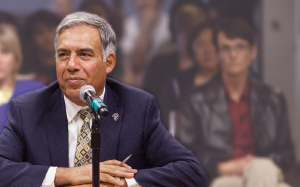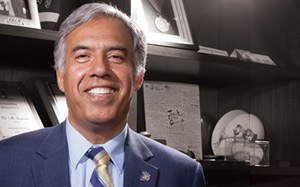New growth in higher ed

Provost Ellen Junn discusses how San José State’s latest approaches to teaching and learning are shaking up classrooms—on campuses and in the cloud.
Public institutions of higher education—in California, and across the nation—face formidably urgent challenges. Lieutenant Governor Gavin Newsom, who serves on the California State University’s Board of Trustees and as a University of California regent, recently declared California’s education system in code red: insolvent and unresponsive to student needs.
Under the leadership of President Mo Qayoumi and Provost Ellen Junn, San José State is taking the lead in trying new solutions. In 2012, the university emerged on the state, national and global stage as the first public university to partner with online education providers to offer a small pilot of five courses for credit.
Debate continues to attract media worldwide. Here, Junn speaks about the controversy and what it’s like for San José State to be a testing ground for “unbounded learning” in the middle of Silicon Valley.
“I’m interested in problem solving.”
I’ve always loved learning. It’s what propelled me through college and graduate school and into the next step of working in academia. I became a professor to pass that love for learning and knowledge down to the next generation. And, later, became an administrator out of concern for education and making it work.
Part of my reason for coming to San José State in 2012 was my interest in addressing why we have a lower than average graduation rate. We are located in this high-tech center and the eligibility index for our students is relatively high, so why is it that our students are taking much longer to graduate and having more difficulty, on average, than the CSU’s average for students?
I didn’t realize until I got here how many infrastructure improvements were either in progress—or being addressed for the first time. Unlike most campuses, there had been no central rollout of computers. Also, WiFi was not available everywhere on campus, including in the dorms and some classrooms. And labs and classrooms were outdated. As some indication, Hollywood came here in the 1990s for the remake of the film Flubber because they needed a classroom that looked circa 1940. Also, academic technology support needed significant updating.
I arrived with experience using academic technology to support faculty members. At CSU Fullerton, back in 1997, I’d founded and directed the Faculty Development Center, which focused on supporting faculty members in teaching, learning and research, as well as service learning and assessment. It also provided support to faculty members for using technology. I was senior academic technology advisor at Fresno State, in addition to associate provost.
“A class as a ‘living laboratory.’”
 In May 2012, as the MOOC (massive open online course) madness was starting to unfold, we learned that MIT/Harvard had produced a $60 million venture called edX. President Qayoumi had met Anant Argarwal, edX president, who had delivered the keynote at the Tech in Education conference in Santa Clara. He spoke to Anant about SJSU’s interest in edX’s work. Later, I met with Anant to explore edX, and I offered an SJSU class as a “living laboratory.” At that point, Anant’s own electrical engineering course drew 130,000 students worldwide, though not necessarily college students. He said, “If you give me three faculty members and one graduate student, I’ll fly them to Boston and have them work with my team.”
In May 2012, as the MOOC (massive open online course) madness was starting to unfold, we learned that MIT/Harvard had produced a $60 million venture called edX. President Qayoumi had met Anant Argarwal, edX president, who had delivered the keynote at the Tech in Education conference in Santa Clara. He spoke to Anant about SJSU’s interest in edX’s work. Later, I met with Anant to explore edX, and I offered an SJSU class as a “living laboratory.” At that point, Anant’s own electrical engineering course drew 130,000 students worldwide, though not necessarily college students. He said, “If you give me three faculty members and one graduate student, I’ll fly them to Boston and have them work with my team.”
And that’s what happened. Our faculty members and a grad student flew back East and learned how they might adopt Anant’s electronic circuits course. But the faculty members had never taught a course completely online, so they asked if they could design one section as a “flipped” hybrid course and offer it in fall 2012. Students watched the edX videos and used other online resources before coming to class and, in class, worked in teams of three, along with their SJSU professor, to solve problems. There were also in-class quizzes. That pilot was very successful—with the pass rate rising from 59 percent to 91 percent.
“SJSU is not, strictly speaking, using MOOCs.”
Venturing into the MOOC world was, on my part, an attempt to investigate a new learning environment. Instead of listening to all the media hype about MOOCs, we wanted to figure out how they might work for real SJSU students and real SJSU faculty members. The MOOC movement had gotten off to a start before our first experiment, involving people all over the world in large numbers. Yet, little data existed. I wanted to bring all the speculation down to science, to get the data.
I should clarify, what we’ve been doing at SJSU is not, strictly speaking, using MOOCs. Our courses are not free and they’re not by any means massive. In fall 2012, we used edX material in one of our campus-based electronic circuits classes. It was not an online course at all. During spring and summer 2013, our three Udacity courses, which we call “SJSU Plus,” were conducted entirely online and cost $150 each. During the spring, each class involved only a hundred students, from both San José State and outside of the university. And we intentionally focused on at-risk or historically under-served students. In summer 2013, we added two more SJSU Plus courses and expanded enrollment slightly to involve a wider range of students. What’s important about our SJSU Plus courses with Udacity is that our San José State faculty members created the course content.
The tremendous amount of media attention on MOOCs made our experience very public. After our spring courses offered through our partnership with Udacity, faculty unions leaked the “pass rates,” and did so without a full understanding of the student demographics. Many of the media conclusions were prematurely and inappropriately drawn, and it was difficult for us to get the media to focus on the real question: Does this format improve or sustain student learning—or not, given the various student populations?
I explained to the media, “Look, we wanted to start with the high-risk students in addition to regular students.” The initial goals for this pilot were clear: to determine how MOOCs might be used for remedial, high-risk or underprepared students and for high school students preparing for college. Our partner, Sebastian Thrun at Udacity, also has a deep interest in reaching all kinds of people at varying levels of ability. Our intent was to try to pilot different kinds of learning modalities. Unfortunately, based on the initial leaked results, the media took the view, “Pilot has failed. MOOCs are dead.” They printed what aligned with their story line. But they didn’t have all of the details.
From the spring pilot, we learned that a more detailed orientation would help students’ understanding of how to do well in an online course. In the summer session when our faculty members welcomed students, they warned students that they must completely change their ways of approaching learning in an online course. Some faculty members gave students a self-survey, which helped students determine if they could work in a self-structured environment.
From the National Science Foundation-funded evaluation (available online), we learned that the level of student involvement is the number one predictor of success (over socio-economic status). It’s interesting data. The relationship between the number of problem sets solved and success is not linear. Instead, a dramatically positive effect emerges after a certain consistency of effort is made. If students showed consistent, sustained effort, even some of the at-risk students passed.
“For me, it’s all about student learning.”
There is still work to do in streamlining the administrative, operational “nuts and bolts.” We need to make registration seamless, and consider using one learning management system instead of two. (Students go to the Udacity site for class and to Canvas, SJSU’s learning management system, for administration.) Also, we need to solve computer access problems for some students, and make sure that all students know about course mentors and other resources available to them.

Today, our faculty members are continuing to improve their courses, building glossaries and developing course tools. Each course has a team of five to seven people working on it, between SJSU and Udacity. We are at a highly experimental stage, but SJSU is a national leader in offering a larger menu for student learning, whether it’s face-to-face, online or hybrid. The most rewarding part of this work is being involved in the search for knowledge and then to disseminate it and pass it on.
I was a professor for many years, specializing in the cognitive development of young children during the language acquisition period. In addition to my basic research, I worked with children in disadvantaged families, and on legislation that addressed the question of how to build better early childhood programs for students and teachers.
This is my 27th year in the CSU system, with five years at CSU San Bernardino followed by 17 at Fullerton. One day, I was asked to apply for the associate provost position at Fresno State. I was at Fresno State for three and a half years when I got the call from San José State. Although some people might think I’m a career administrator, the truth is that becoming an administrator was relatively recent and serendipitous. For me, it’s all about student learning and helping faculty members be effective, both in class and online. We have such amazing students and talented faculty members at San José State. Our edX and Udacity pilots have been an opportunity to see how our students learn in these new environments. We may not have answers for all of the challenges facing our students and higher education. But the questions remain strong motivators for me.
C.S. Walker’s work has been published, cited and/or reviewed in The Wall Street Journal, LA Times, Harper’s Magazine, Utne Reader, Irish Pages, Whole Earth Review and The Ecologist.
Want to ensure that SJSU students and faculty members learn and teach on their own terms? Support unbounded learning.



